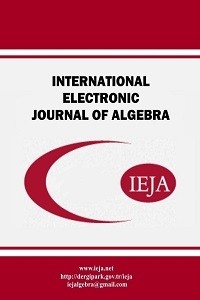On I-finite left quasi-duo rings
A ring is called left quasi-duo (left QD) if every maximal left ideal is a right ideal, and it is called I-finite if it contains no infinite orthogonal set of idempotents. It is shown that a ring is I-finite and left QD if and only if it is a generalized upper-triangular matrix ring with all diagonal rings being division rings except the lower one, which is either a division ring or it is I-finite, left QD and left `soclin' (left QDS). Here a ring is called left soclin if each simple left ideal is nilpotent. The left QDS rings are shown to be finite direct products of indecomposable left QDS rings, in each of which 1=f1+⋯+fm1=f1+⋯+fm where the fifi are orthogonal primitive idempotents, with fk≈flfk≈fl for all k,l,k,l, and ≈≈ is the block equivalence on {f1,…,fm}.{f1,…,fm}.A ring is shown to be left soclin if and only if every maximal left ideal is left essential, if and only if the left socle is contained in the left singular ideal. These left soclin rings are proved to be a Morita invariant class; and if a ring is semilocal and non-semisimple, then it is left soclin if and only if the Jacobson radical is essential as a left ideal..Left quasi-duo elements are defined for any ring and shown to constitute a subring containing the centre and the Jacobson radical of the ring. The `width' of any left QD ring is defined and applied to characterize the semilocal left QD rings, and to clarify the semiperfect case..
Keywords:
Left quasi-duo ring, left soclin ring, generalized triangular matrix ring, left-max ideal, ideal-simple module left socle, very semisimple module,
___
- F. W. Anderson and K. R. Fuller, Rings and Categories of Modules, Second Edition, Springer-Verlag, New York, 1992.
- R. Brauer, Harvard Lectures on the Wedderburn Theorems, 1950.
- W. Burgess and W. Stephenson, Rings all of whose Pierce stalks are local, Canad. Math. Bull., 22(2) (1979), 159-164.
- V. P. Camillo and H.-P. Yu, Exchange rings, units and idempotents, Comm. Algebra, 22(12) (1994), 4737-4749.
- P. Crawley and B. Jonsson, Refinements for infinite direct decompositions of algebraic systems, Pacific J. Math., 14 (1964), 797-855.
- M. P. Drazin, Rings with central idempotent or nilpotent elements, Proc. Edinburgh Math. Soc., 9 (1958), 157-165.
- E. H. Feller, Properties of primary noncommutative rings, Trans. Amer. Math. Soc., 89 (1958), 79-91.
- K. R. Goodearl, Ring Theory, Nonsingular Rings and Modules, Marcel Dekker, Inc., New York-Basel, 1976.
- C. Huh, S. H. Jang, C. O. Kim and Y. Lee, Rings whose maximal one-sided ideals are two-sided, Bull. Korean Math. Soc., 39(3) (2002), 411-422.
- N. Jacobson, Some remarks on one-sided inverses, Proc. Amer. Math. Soc., 1 (1950), 352-355.
- C. O. Kim, H. K. Kim and S. H. Jang, A study on quasi-duo rings, Bull. Korean Math. Soc., 36 (1999), 579-588.
- N. K. Kim and Y. Lee, On right quasi-duo rings which are $\pi$-regular, Bull. Korean Math. Soc., 37 (2000), 217-227.
- T. Y. Lam, A First Course in Noncommutative Rings, Springer-Verlag, New York, 1991.
- T. Y. Lam and A. S. Dugas, Quasi-duo rings and stable range descent, J. Pure Appl. Algebra, 195 (2005), 243-259.
- J. C. McConnell and J. C. Robson, Noncommutative Noetherian Rings, John Wiley & Sons, Ltd., Chichester, 1987.
- W. K. Nicholson, Lifting idempotents and exchange rings, Trans. Amer. Math. Soc., 229 (1977), 269-278.
- W. K. Nicholson, Very semisimple modules, Amer. Math. Monthly, 104(2) (1997), 159-162.
- W. K. Nicholson and E. S´anchez Campos, Rings with the dual of the isomorphism theorem, J. Algebra, 271 (2004), 391-406.
- W. K. Nicholson and M. F. Yousif, Quasi-Frobenius Rings, Cambridge Tracts in Mathematics, 158, Cambridge University Press, Cambridge, 2003.
- L. Rowen, Ring Theory, Volume I, Academic Press, Inc., Boston, MA, 1988.
- J. C. Shepherdson, Inverses and zero-divisors in matrix rings, Proc. London Math. Soc., (3)1 (1951), 71-85.
- R. Warfield, Exchange rings and decompositions of modules, Math. Ann., 199 (1972), 31-36.
- H.-P. Yu, On quasi-duo rings, Glasgow Math. J., 37 (1995), 21-31.
- ISSN: 1306-6048
- Yayın Aralığı: Yılda 2 Sayı
- Başlangıç: 2007
- Yayıncı: Abdullah HARMANCI
